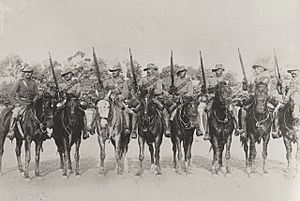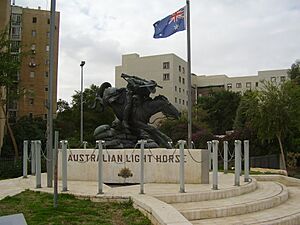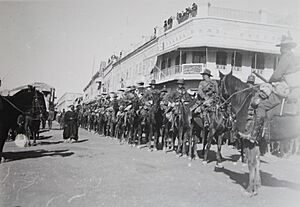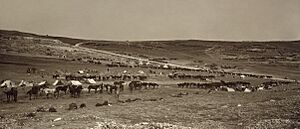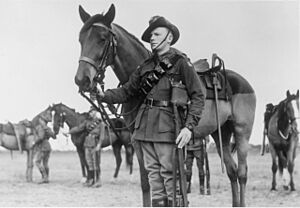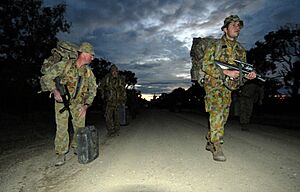Australian Light Horse facts for kids
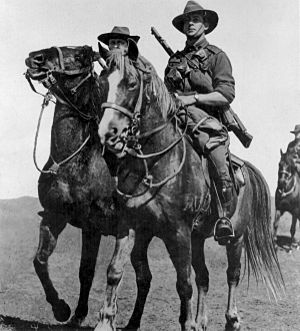
The Australian Light Horse were special soldiers who rode horses. They were a mix of cavalry (soldiers who fight on horseback) and mounted infantry (soldiers who ride to battle but fight on foot). These brave troops served in the Second Boer War and World War I.
After World War I, many Light Horse units continued as part-time military forces in Australia. Over time, these units changed. They became more modern, using vehicles instead of horses, especially before and during World War II. Today, some Australian Light Horse units still exist, keeping their history alive.
What Were the Australian Light Horse?
How the Light Horse Began
In the late 1800s and early 1900s, military leaders in Australia discussed the best way to use mounted troops. Australia is a very large country with few people in many areas. This made it hard to have big armies like those in Europe. Also, Australia faced droughts and money problems, so they mostly relied on volunteer soldiers.
The Second Boer War in South Africa showed a new way of fighting. The Boers used mobile tactics, moving quickly and fighting in small groups. Australian leaders thought this style would work well for defending their vast country. So, volunteer Light Horse Regiments were formed across Australia. These units were supported by local Rifle Clubs, which helped train new soldiers.
The idea was that if Australia ever needed defending, these mobile soldiers could fight a large-scale guerrilla war. This would make it very difficult for any invading force. This focus on mobile, mounted infantry was key to Australia's defense until 1910. At that time, a report suggested that Australian forces should be ready to join larger international forces. This plan included creating two mounted divisions.
By the start of World War I, Australia had 23 Light Horse regiments. These included about 9,000 soldiers who were part of Australia's part-time military. They were organized into several brigades across different states.
Light Horse in World War I
Fighting on Horseback and Foot
Light Horse soldiers were mostly like mounted infantry. This means they rode their horses to get to the battlefield quickly. Once there, they would usually dismount (get off their horses) to fight on foot. Their horses would then be led away to safety, ready for a quick escape if needed.
A famous example of their bravery was the charge at Beersheba on October 31, 1917. Here, the 4th and 12th Light Horse Regiments charged on horseback, which was unusual for them. Later in 1918, some Light Horse regiments even used sabres (swords) to fight like traditional cavalry during the advance on Damascus. They also did important cavalry jobs like scouting and looking for enemy movements while mounted.
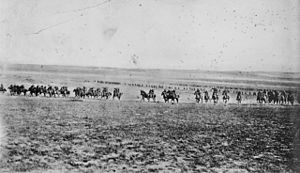
Light Horse regiments were set up like cavalry units. A regiment had about 25 officers and 400 men. This was smaller than an infantry battalion, which had around 1,000 men. When fighting, about a quarter of the soldiers would be assigned to hold the horses.
Each regiment was divided into three squadrons (named "A", "B", and "C"). Each squadron had four troops, and each troop had about 10 sections of four men. When soldiers dismounted for battle, one man from each section would hold the reins of the other three men's horses. He would then lead the horses away from the fighting until they were needed again.
At first, each regiment had a troop with two Maxim guns. During the Gallipoli Campaign, where the Light Horse fought on foot, this number increased to four guns. Later, these guns were grouped into special machine gun squadrons, giving the Light Horse more powerful weapons like the Vickers machine gun and later the Hotchkiss M1909 Benét–Mercié machine gun.
The Waler horse was the perfect mount for the Light Horsemen. These Australian horses were strong and tough, which was essential for surviving in the hot desert. Many horses were left in Egypt to get used to the climate while the soldiers fought in Gallipoli.
Brave Indigenous Soldiers
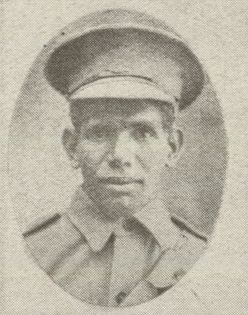
Even though Indigenous men were not always welcomed into the Australian Armed Forces, some managed to join the Australian Light Horse. In the Army, everyone received the same pay, unlike in civilian life where Indigenous men often earned less. This, along with patriotism, was a reason for many to enlist. Several Indigenous soldiers fought bravely during the Gallipoli campaign. Their skills with horses and their ability to handle hot climates made them valuable members of the Light Horse.
Gallipoli and Desert Campaigns
When World War I began, Australia sent an all-volunteer force called the First Australian Imperial Force. This included an infantry division and a Light Horse brigade. As the war continued, more Light Horse brigades were formed. Eventually, there were five Australian Light Horse brigades.
The Light Horse regiments first saw action in the Gallipoli Campaign. They went to Gallipoli without their horses to help the infantry. They mostly defended positions but also took part in tough battles like the Battle of the Nek. After leaving Gallipoli in December 1915, the Light Horse units regrouped in Egypt. In March 1916, Australian and New Zealand mounted troops formed the Anzac Mounted Division.
Some Light Horse brigades also fought against the Senussi in the western desert of Egypt from late 1915 to 1917. However, their main role was fighting against Ottoman forces in the Sinai and Palestine Campaign from 1916 to 1918.
In 1917, the mounted troops were reorganized into three divisions: the Anzac Mounted Division, the Australian Mounted Division, and the Yeomanry Mounted Division. These three divisions, along with the Imperial Camel Brigade, formed the Desert Mounted Corps. This large force was led by Lieutenant General Harry Chauvel.
Caring for Horses in the Desert
Caring for thousands of horses and mules in the harsh desert was a huge challenge. Sadly, many animals became sick or died.
Light Horse on the Western Front
While many Light Horse units fought in the Middle East, some also served on the Western Front in Europe. The 13th Light Horse Regiment and a squadron from the 4th Light Horse Regiment were among these. They acted as cavalry for different divisions and later formed part of larger mounted regiments. These units played important roles in scouting and other cavalry duties during major battles in 1918.
After World War I: New Roles
After World War I, the Light Horse regiments were organized into six cavalry brigades. These brigades formed two cavalry divisions.
By the start of World War II, there were 25 Light Horse regiments. Most of these still used horses, but they were also starting to use vehicles. Some regiments had already become machine gun regiments or armoured car regiments. During World War II, many Light Horse units changed completely. They became motorised infantry (soldiers who ride in vehicles), armoured car units, or armoured regiments. They mostly helped defend Australia.
As the threat of invasion lessened, most of these units were disbanded in 1943 or 1944. Their soldiers were then sent to other units. By 1945, only two Light Horse units remained. The 20th Light Horse Regiment became the 20th Motor Regiment and served overseas. The 1st Light Horse Regiment became the 1st Tank Battalion and fought in New Guinea and Borneo.
Lasting Legacy of the Light Horse
The spirit of the Australian Light Horse lives on today!
- Many Australian Light Horse units still exist. They are now part of the Royal Australian Armoured Corps (RAAC) and serve as modern cavalry units. Examples include the 1st/15th Royal New South Wales Lancers and the 2nd/14th Light Horse Regiment (Queensland Mounted Infantry).
- A special memorial to the Australian Light Horse was opened in Tamworth in 2005.
- The Light Horse are also remembered by the Light Horse Interchange on the M4 motorway in Western Sydney. This interchange features sculptures that honor their history.
- On April 28, 2008, a monument to the Light Horse was unveiled in Beersheba, Israel. It was created by Australian sculptor Peter Corlett.
- On October 31, 2017, the Beersheba Anzac Memorial Centre was opened. This center looks like a horse's head and remembers the thousands of horses that served and died in the war. It also has a small collection of war items. The ANZAC Trail allows people to retrace the cavalry's journey to the Battle of Beersheba.
- On September 26, 2019, a life-size sculpture called The Aboriginal and His Horse was dedicated at Tzemach. This sculpture honors Aboriginal ANZAC members, including cavalrymen who fought in the region.
- A statue of Sir William Glasgow, an officer of the Australian Light Horse, was unveiled in Brisbane in 1966. It was later moved to Post Office Square, Brisbane in 2008.
- Commemorations of the Battle of Beersheba happen every year on October 31 at the memorial in Canberra. Larger gatherings take place on special anniversary years.
- In 1931, Dorothy Brooke, an Englishwoman, started a charity called Brooke. This charity helps working horses, donkeys, and mules around the world. She was inspired by the old army horses sold in Egypt after the war.
- Many descendants of these army horses are still used today. They carry tourists around the pyramids of Giza and provide transport for local Egyptians.
- After tourism in Egypt slowed down in 2011, animal charities like Brooke and Egypt Equine Aid stepped in to help care for these horses.
- Light Horse Memorial Park in Seymour, Victoria, is located on part of the land where the Australian Light Horse trained during World War I.
See Also
- Arab Revolt
- Light horse field ambulance
- Middle Eastern theatre of World War I
- Military history of Australia during World War I
- Horses in World War I
- Light Horse Regiment (South Africa)
- South Alberta Light Horse (Canada)


